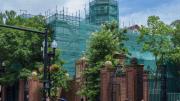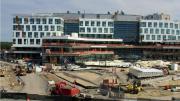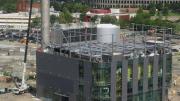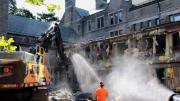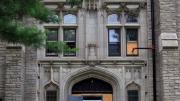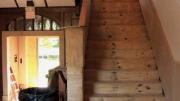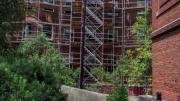Nominally, Harvard’s official color is crimson. But this summer, a lot of the place went green—with numerous sites swaddled in or fenced off by construction wrapping, Christo-style, during another busy season of renewal, renovation, and repair.
The big-ticket new construction remains the action in Allston, during the final year of work on the billion-dollar science and engineering complex, to which much of that faculty will relocate next summer. (Renovation of 114 Western Avenue, part of the same project, is concluding; it will house School of Engineering and Applied Sciences staff, classrooms, and a new childcare center.) But in toto, Harvard’s numerous lower-profile jobs probably create just as much work for architects and members of the building trades, if not more.
As contractors put the finishing touches on Lowell House—the largest House-renewal project to date—the hard, hot work of tearing into Adams House’s below-grade utilities and infrastructure, and of gutting Claverly Hall and Senior House, got under way directly across Mount Auburn Street (see harvardmag.com/adams-renewal-19). The Lowell flag and shield came down at the former Inn at Harvard, now swing housing, and Adams insignia took their place.
A year-long updating, inside and out, of Radcliffe Institute’s Schlesinger Library neared completion, yielding new exhibit spaces, a technologically spiffed-up seminar room, and other twenty-first-century enhancements.
Last year, in Harvard Yard, Massachusetts Hall underwent its own makeover, welcoming a new president to refreshed offices. But no peace in the neighborhood: beginning in June, just across the roadway entering from Johnston Gate, Harvard Hall was “taken offline.” Its mechanical systems were in dumpsters within days, the first step toward a wholesale redoing of the teaching spaces within, and restoration of the masonry and cupola. Classes will resume by January, at the start of what is (laughably) called “spring” semester.
Notable high-altitude nips and tucks administered during the long-daylight months included redoing the roof atop Sanders Theatre—the first phase of an ambitious reroofing of the entire Memorial Hall, after 140-plus years of service by the original slates; tweaking the subroofing ’neath the Sever tiles, and touching up some stonework and tiles themselves; fixing part of the Carpenter Center roof (do you detect a theme?) and installing ventilation for new, laser-cutting equipment being brought online for the cutting-edge artists; and forging ahead on replacing the biological laboratories’ massive heating, ventilating, and air-conditioning systems with more energy-efficent ones. Unaccountably, mere months after its opening (“Harvard Hubs,” November-December 2018, page 24), Smith Campus Center was scaffolded again, for reroofing—adding to intense construction, both commercial and for the MBTA’s elevator and bus tunnel, in tourist-clogged Harvard Square. (Note to sidewalk superintendents: if you missed out making millions in software, think scaffolding; somebody is billing handsomely for all those pipes and joints.) On terra firma, the Graduate School of Design invested in re-waterproofing Gund Hall’s entry plaza.
Farther afield, adjacent to Harvard Business School, a massive, multiyear renovation of the Soldiers Field Park housing complex continued apace. And to the north, in Cambridge, other faculties joined in the uproar, with two big jobs breaking ground. The Law School started to refurbish and augment its Lewis International Law Center, with a western addition and a new top floor, all scheduled for completion in mid 2021. And perhaps the largest project, relative to the size of the facilities and campus, is the wholesale reshaping of the Divinity School’s central space, including catching up on deferred maintenance, replacing internal systems, and augmenting and adding to classrooms and common spaces—all behind spiritually soothing patterned green fencing. When complete in 18 months, the 1911 building née Andover Hall will have emerged transformed, earning its way into its new identity as Swartz Hall.
For the third year running, it looks as though the Boston-area construction industry will have nearly a billion reasons to say “thank you” to Harvard. Given the projects on deck—remaining House renewals, the Design School’s planned expansion, and the projected huge first stage of developing the commercial “enterprise research campus” in Allston, the hard hats’ good times seem likely to roll on.
